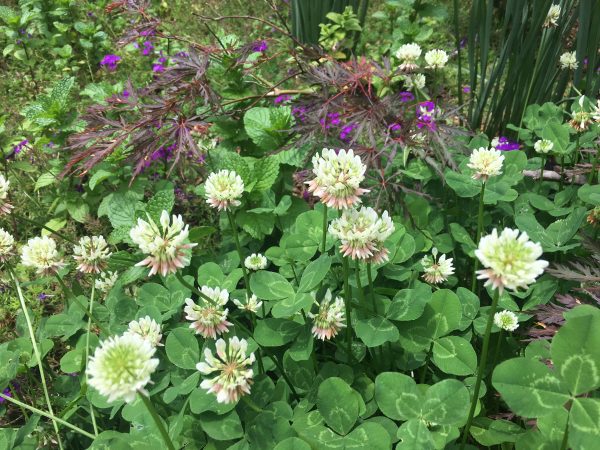Make your own luck with clover

Growing up in the Uwharries, my sister and I were country girls through and through, right down to the soles of our feet. We went barefoot much of the summer. The red clay stained our feet the color of rust. Our calluses allowed us to traverse the gravel driveway and cross the gooey asphalt on our daily run to the mailbox. We stepped on briars, pop tops (remember the days when they didn’t remain attached to the can?) and countless honeybees in the clover that dotted our yard.
Before the widespread availability of broadleaf herbicides, white clover (Trifolium repens) was actually included in standard seed mixes. It later became possible – and even fashionable – to eradicate clover and other “weeds” from a lawn, creating a monoculture of high-maintenance fescue. We never embraced this ideal in our remote corner of the Uwharries, but it’s on display in cities, towns and suburbs across the Piedmont. This summer, in my somewhat quirky urban neighborhood, I’m sensing the return of a less meticulous aesthetic. More and more, I’m spotting patches of clover interspersed among the turf.
It appears word is getting out about the dire situation facing many pollinators, especially honeybees (Apis mellifera). Like white clover, honeybees are also native to Europe, brought here by early colonists. Maybe that’s why the two have such an affinity – they’re compatriots in a strange land.
Once honeybees find a patch of clover, they happily visit other flowers in the vicinity. A few years ago, a neighbor realized her cucumber vines weren’t producing because the blooms weren’t being pollinated. After going to great lengths to hand-pollinate, she began to coddle her clover. She recently found a sign on Etsy and posted it in her yard: Pardon the Weeds, I’m Feeding the Bees.
Clover can assist gardeners in a totally different way. Another neighbor keeps a patch of clover in her backyard, hoping it will satisfy the pesky rabbits that otherwise nibble on her tender vegetables. This is a reasonable strategy. Many game species, including deer and turkey, appreciate clover, making it a popular choice for hunters who want to establish productive food plots. White clover is also palatable forage for livestock.
People who aren’t into vegetable gardening still have plenty of reasons to cultivate a clover lawn. Maintaining a lush fescue monoculture is an expensive time sink of mowing, irrigating and applying expensive chemicals. Clover is hard to eradicate and easy to grow. Why fight it? Clover stays green and dense and low, spreading by seeds and runners. And because it fixes nitrogen, it can actually improve the health of surrounding fescue and reduce the need for fertilizer. It out-competes other, less attractive “weeds.” Clover feels good under foot and holds up well to moderate traffic. If you’re worried about stepping on a bee, mow at a lower setting to knock back the flowers during its bloom season.
 Clover flowers on the campus of Davidson College. Photo: Ruth Ann Grissom
Clover flowers on the campus of Davidson College. Photo: Ruth Ann Grissom
There are so many benefits to clover, some people aspire to do away with grass entirely. Truthfully, doing so sounds like a lot of work. A clover-riddled lawn, like summer itself, ought to be about easy living.
On the Wing Haven garden tour this spring, I even saw clover used to show-stopping effect in a flower bed. A visionary gardener had placed it at the foot of a lacy Japanese maple. The burgundy leaves were echoed in the tinge of pink on the drooping buds at the base of the clover’s spherical flower head. In that setting, I also found a new appreciation for the white design on the leaves, delicate as a watermark. The clover held its own among culinary mint and purple verbena, ground covers that can be thuggish.
After nearly 50 years, I don’t remember being incapacitated by those honeybee stings. We tried all sorts of home remedies, including a poultice of tobacco, which is no doubt frowned upon these days. What I recall more vividly is the joy associated with clover – picking them by the dozen (close to the ground to keep the stems as long as possible), puncturing the end with a sharp thumbnail, then gently enlarging the slit to admit a flower head, a small miracle repeated again and again until the chain was long enough to encircle our necks or wrists. Thus adorned, we’d turn our attention to the foliage. Alas, we didn’t inherit Mama’s knack for spotting four-leaf clovers. According to The Old Farmer’s Almanac, the chance of this aberration is only one in 10,000. At our home in the Uwharries, we must have been surrounded by an abundance of luck.